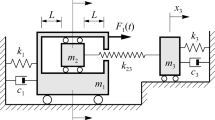Abstract
This paper studies the transfer of energy accompanying the impact of two otherwise linear, viscously damped, single-degree-of-freedom oscillators, one of which is driven by harmonic base motion. A semi-analytical solution of the oscillator equations of motion, in which the times of impact are determined by bisection, is used to simulate the responses while the parameters of the system are varied. The existence of a stable 1:1 resonance, which means the response is stable and both oscillators vibrate with the period of the excitation, is investigated using Floquet theory, and predictions are made about the ranges of excitation frequency and amplitude leading to such a response. It is found that the assumption of a coefficient of restitution, defined as the ratio of the relative velocity of the two oscillators after their collision to their relative velocity before collision, smaller than 1 (i.e., modeling energy loss during impact) increases the range of stable solutions. A transmission coefficient, the ratio of transmitted energy to input energy, is defined to quantify the efficiency of energy transfer between the oscillators, and it is found that the energy transmission efficiency from the higher-frequency oscillator to the lower-frequency one is much greater than the transmission efficiency for energy flow from the lower-frequency to the higher-frequency oscillator. There is an optimal excitation amplitude for maximum energy transfer in higher-to-lower-frequency transmission, while such an optimum does not exist for transmission in the opposite direction. The numerical results are validated by experiments.












Similar content being viewed by others
References
Goyder, H., White, R.G.: Vibrational power flow from machines into built-up structures, part I: introduction and approximate analyses of beam and plate-like foundations. J. Sound Vib. 68, 59–75 (1980)
Goyder, H., White, R.G.: Vibrational power flow from machines into built-up structures, part II: Wave propagation and power flow in beam-stiffened plates. J. Sound Vib. 68, 77–96 (1980)
Goyder, H., White, R.G.: Vibrational power flow from machines into built-up structures, part III: power flow through isolation systems. J. Sound Vib. 68, 97–117 (1980)
Pinnington, R.J., White, R.G.: Power flow through machine isolators to resonant and non-resonant beams. J. Sound Vib. 75, 179–197 (1981)
Guyader, J.L., Boisson, C., Lesueur, C.: Energy transmission in finite coupled plates, part I: theory. J. Sound Vib. 81, 81–92 (1982)
Boisson, C., Guyader, J.L., Millot, P., Lesueur, C.: Energy transmission in finite coupled plates, part II: application to an L shaped structure. J. Sound Vib. 81, 93–105 (1982)
Gibbs, B.M., Tattersall, J.D.: Vibrational energy transmission and mode conversion at a corner-junction of square section rods. J. Vib. Acoust. Stress Reliab. Des. 109, 348–355 (1987)
Xiong, Y.P., Xing, J.T., Price, W.G.: Power flow analysis of complex coupled systems by progressive approaches. J. Sound Vib. 239, 275–295 (2001)
Ji, L., Mace, B.R., Pinnington, R.J.: A power mode approach to estimating vibrational power transmitted by multiple sources. J. Sound Vib. 265, 387–399 (2003)
Royston, T.J., Singh, R.: Optimization of passive and active non-linear vibration mounting systems based on vibratory power transmission. J. Sound Vib. 194, 295–316 (1996)
Royston, T.J., Singh, R.: Vibratory power flow through a nonlinear path into a resonant receiver. J. Acoust. Soc. Am. 101, 2059–2069 (1997)
Carrella, A., Brennan, M.J., Waters, T.P., Lopes Jr., V.: Force and displacement transmissibility of a nonlinear isolator with high-static-low-dynamic-stiffness. Int. J. Mech. Sci. 55, 22–29 (2012)
Yang, J., Xiong, Y.P., Xing, J.T.: Dynamics and power flow behaviour of a nonlinear vibration isolation system with a negative stiffness mechanism. J. Sound Vib. 332, 167–183 (2013)
Yang, J., Xiong, Y.P., Xing, J.T.: Nonlinear power flow analysis of the Duffing oscillator. Mech. Syst. Signal Process. 45, 563–578 (2014)
Yang, J., Xiong, Y.P., Xing, J.T.: Power flow behaviour and dynamic performance of a nonlinear vibration absorber coupled to a nonlinear oscillator. Nonlinear Dyn. 80, 1063–1079 (2015)
Yang, J., Xiong, Y.P., Xing, J.T.: Vibration power flow and force transmission behaviour of a nonlinear isolator mounted on a nonlinear base. Int. J. Mech. Sci. 115, 238–252 (2016)
Yang, J., Shi, B., Rudd, C.: On vibration transmission between interactive oscillators with nonlinear coupling interface. Int. J. Mech. Sci. 137, 238–251 (2018)
Shi, B., Yang, J.: Quantification of vibration force and power flow transmission between coupled nonlinear oscillators. Int. J. Dyn. Control. (2019). https://doi.org/10.1007/s40435-019-00560-7
Shi, B., Yang, J., Rudd, C.: On vibration transmission in oscillating systems incorporating bilinear stiffness and damping elements. Int. J. Mech. Sci. 150, 458–470 (2019)
Dai, W., Yang, J., Shi, B.: Vibration transmission and power flow in impact oscillators with linear and nonlinear constraints. Int. J. Mech. Sci. 168, 105234 (2020)
Grinberg, I., Vakakis, A.F., Gendelman, O.V.: Acoustic diode: wave non-reciprocity in nonlinearly coupled waveguides. Wave Motion 83, 49–66 (2018)
Nayfeh, A.H., Mook, D.T.: Nonlinear Oscillations. Wiley, Hoboken (2008)
Fredriksson, M.H., Nordmark, A.B.: On normal form calculations in impact oscillators. Proc. R. Soc. Lond. Ser. A Math. Phys. Eng. Sci. 456, 315–329 (2000)
Acknowledgements
This research was supported by the “One Belt One Road” program through Zhejiang Province and the Zhejiang University of Technology-Institute of Applied Physics, Russian Academy of Sciences Joint Research Laboratory of Innovative Technology of Acoustics and Vibration through Grant No. 2018C04018, the Ministry of Science and Technology of China through Grant No. 2017YFC0306202, the National Natural Science Foundation of China through Grant No. 51975525. The authors are grateful to Peizhe Li and Zhan Yao for their contributions in designing and building the experimental apparatus, and to Prof. Chin An Tan for his insightful comments on the work and its presentation.
Author information
Authors and Affiliations
Corresponding author
Ethics declarations
Conflict of interest
The authors declare that they have no conflict of interest.
Additional information
Publisher's Note
Springer Nature remains neutral with regard to jurisdictional claims in published maps and institutional affiliations.
Rights and permissions
About this article
Cite this article
Huang, T., McFarland, D.M., Vakakis, A.F. et al. Energy transmission by impact in a system of two discrete oscillators. Nonlinear Dyn 100, 135–145 (2020). https://doi.org/10.1007/s11071-020-05524-7
Received:
Accepted:
Published:
Issue Date:
DOI: https://doi.org/10.1007/s11071-020-05524-7




